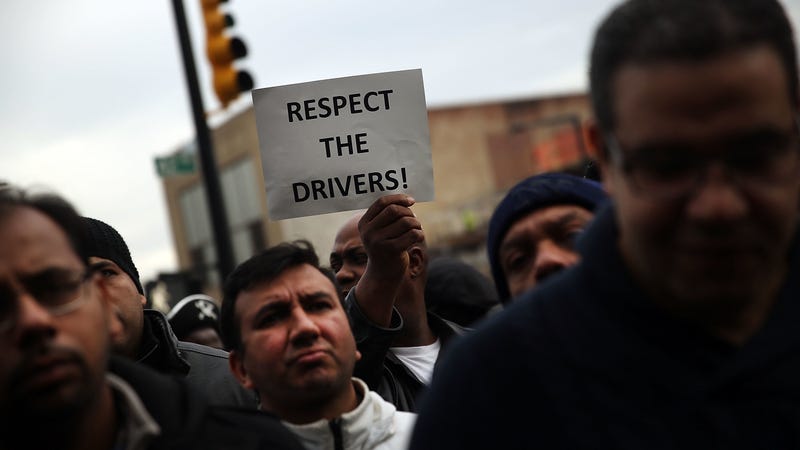 Photo: Spencer Platt (Getty)
Photo: Spencer Platt (Getty)
It’s a company used to the spotlight, but the biggest day in Uber’s history is still ahead: The richest and most highly anticipated IPO of the year is just around the corner.
But a group of drivers dissatisfied with shrinking pay, no benefits, a lack of transparency, and little voice within the company are hoping to turn that singular IPO moment in their own favor by organizing a seven-city strike around the country including at Uber headquarters for 12 hours on May 8 leading up to Uber’s initial public offering.
The strike is being organized by drivers across various online groups and is being backed by advocacy groups like Gig Workers Rising in California and Chicago Rideshare Advocates. Drivers in San Francisco, San Diego, Los Angeles, Chicago, Minneapolis, Philadelphia, and Washington, D.C., are slated to join the 12-hour shutdown next month.
“We want a living wage,” Uber driver and organizer Mostafa Maklad told Gizmodo. “Most of drivers living in San Francisco are forced to work at least 70-80 hours a week in order to survive in the city. Living expenses increase, gas prices increase, food expenses increase, everything is getting more expensive in order to live in San Francisco. We have to drive more and more, deal with health and stress problems, but Uber doesn’t care. What uber is doing is decreasing pay to drivers.”
Drivers have four basics demands: increased pay, basic benefits, decision-making transparency, and a greater voice for drivers. Uber did not respond to a request for comment and, unlike competitor Lyft, has never once met with organizing drivers.
In the last few months, as Lyft made its initial public offering and Uber is ramping up to its own much bigger event, drivers have been increasing organizing efforts as pay rates have fallen around the country.
Various studies have shown the median hourly pay for Uber drivers to go as low as $14 per hour to $9.21 per hour.
Not too long ago, Uber bragged that drivers working at least 40 hours a week could earn over $90,000 a year in New York City. Now the company, which suddenly pretends that only part-timers should drive despite earlier messaging, offered until recently an hourly rate of just over $20 per hour in New York City. That’s over 75 hours of work per week, the equivalent of two jobs, with no health care or benefits, in order to reach that advertised figure.
It used to be that everyone thought gig workers and rideshare drivers, in particular, were impossible to organize. They’re isolated by design, there is no office or factory where they cross paths, and so the classic labor organizing strategies are far less effective in this 21st-century job.
More and more, however, the drivers and supporting advocacy groups are figuring out a few basic but effective solutions. Huge Facebook groups for drivers are the most common way to trade information, tips, and get help from fellow drivers. There are also WhatsApp groups, hundreds of drivers strong, that exchange information from city to city. It’s not all online, however.
“When I’m at an airport lot, most drivers get out of the car and stretch if the weather is nice,” Uber driver and organizer Rebecca Stack Martinez said. “They congregate and talk about frustrations on fairies and lack of help from Uber. For me that’s an opportunity to jump in and say, I hear what you’re talking about, here are organizations trying to give drivers a voice.”
Even though organizing has been accelerating—Gig Workers Rising, a Northern California group, has 4,000 drivers on its lists, and similar groups exist across the country—there’s so far nothing to show for it in most cities in the United States. When drivers delivered a petition to Lyft and Uber last year protesting how the company opaquely handled driver deactivation, an Uber security guard body slammed the driver with the petition outside of the company’s headquarters. Lyft granted a meeting but ultimately changed nothing.
“The victories are still down the road, nothing has been accomplished,” Stack Martinez said. “But you never expect one action is going to bring about all the change you’re looking for. Any history of organizing will show you it takes time to get what you’re looking for.”
One major exception is New York City, which adopted the nation’s first pay floor for rideshare drivers late last year.
More than just the most hyped IPO of the year, Uber’s public offering is one of the biggest in history with a valuation that could top $120 billion. Don’t let that give you the wrong idea: The company is wildly unprofitable, losing $891 million in a single quarter last year.
The company’s biggest cost by far is drivers, and so while there are countless drivers telling stories about how their own earnings are falling dramatically, most expect their wages to keep going south unless something fundamentally changes. For Uber, that change is the complete elimination of human drivers and replacing them with self-driving vehicles.
Last month, after a long silence and several highly visible actions by drivers, an anonymous Uber employee published a letter supporting organizing drivers, corroborating the injustices the drivers themselves hope to rectify.
“The strikes called on Monday by Rideshare Drivers United (RDU) in Southern California and Gig Workers Rising in San Francisco are a sign of the deep frustration many ride-share drivers feel,” the author wrote. “While ride-share executives continue to receive vast remuneration packages, and internal employees look forward to an IPO windfall at both Uber and Lyft […] drivers are squeezed in order to shore up initial offerings to investors.”
Uber and Lyft employees willing to talk should reach out. Email: poneill@gizmodo.com, Signal: +16504887247, or via our Secure Drop server.
Share This Story